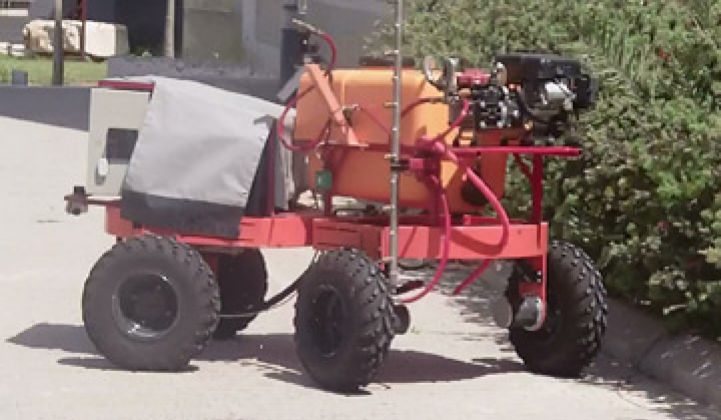Beer Sheba, Israel --- On one hand, you could dismiss this thing in the video and the picture as an intelligent hose.
On the other hand, you could see it as a path toward cleaner agriculture.
The prototype robot is designed to precisely spray water and, more importantly, fertilizer on vegetables and fruit where it is needed, and not on leaves or stems. Right now, sprayers are somewhat indiscriminate, wetting entire areas to make sure the vegetables get hit. If technology like this can become more widespread, fossil fuels -- the main ingredient in fertilizers -- decline in demand on the farm, pollution runoff becomes more manageable and the potential for chemical exposure for workers and consumers decreases.
"This could be a tremendous savings for farmers. With this, you can save 80 percent of the material," said Yael Edan, a professor specializing in t robotics at Ben-Gurion University here. "It would also reduce pesticide pollution."
After it fine-tunes robotic watering and spraying, the team will try to develop a robot that can pick high-value crops like peppers, apples and grapes. (Editor's note: that's not Edan in the video, but one of her grad students.)
It's a lot harder than it may look. Rigging a cart with optical sensors to find fruit by color doesn't work because colors change with light conditions and cloud cover. Peppers also change colors during the ripening process. The system mostly relies on spectroscopy, i.e., measuring the amount of light reflected by different parts of the plant. The flesh of the plant will absorb different amounts of light from the robot's beam than the leaves. This is supplemented with algorithms for geometric pattern matching and robotic behavioral adaptation.
"One of the major problems in agriculture is that it is that the problem is unstructured. Each pepper is different in shape, size and orientation," she said. "Picking needs to consider optimal ripeness and plucking. There will probably be different algorithms for different fruit."
A basic robotic greenhouse sprayer may be ready to go to market in two to three years, while one with somewhat accurate selective spraying may come out in four to five years. Even so, it may not be easy to convince farmers. The current identification techniques can discriminate between fruits and vegetables on one hand and other vegetable matter around 80 percent to 85 percent of the time. Farmers will likely demand 90-percent-plus accuracy.



